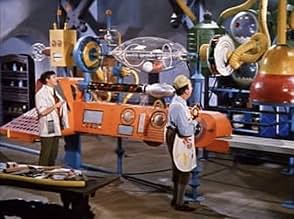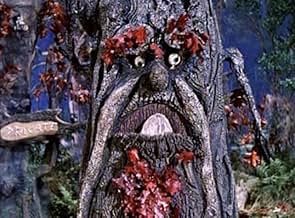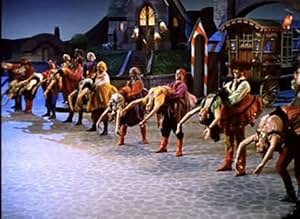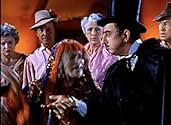NOTE IMDb
6,1/10
5,1 k
MA NOTE
Ajouter une intrigue dans votre langueMary Contrary is set to marry Tom Piper when he is kidnapped by Roderigo and Gonzorgo, two goons working for the evil Barnaby who wants to marry Mary for her inheritance.Mary Contrary is set to marry Tom Piper when he is kidnapped by Roderigo and Gonzorgo, two goons working for the evil Barnaby who wants to marry Mary for her inheritance.Mary Contrary is set to marry Tom Piper when he is kidnapped by Roderigo and Gonzorgo, two goons working for the evil Barnaby who wants to marry Mary for her inheritance.
- Réalisation
- Scénario
- Casting principal
- Nommé pour 2 Oscars
- 1 victoire et 6 nominations au total
Annette Funicello
- Mary Quite Contrary
- (as Annette)
Leon Alton
- Villager
- (non crédité)
Don Anderson
- Villager
- (non crédité)
Marilee Arnold
- Twin
- (non crédité)
Melanie Arnold
- Twin
- (non crédité)
Robert Banas
- Russian Dancer
- (non crédité)
Tex Brodus
- Villager
- (non crédité)
Boyd Cabeen
- Villager
- (non crédité)
Avis à la une
I think that when you're a kid, there are movies you just watch over and over and whether they're any good or not, you associate certain things with that movie. This is one of those movies. I think that my favorite scenes were the musical numbers -- when Annette sings the song about not being able to make ends meet, when the Gypsies come to town (especially that part!) the forest of no return number. It was just a cool movie with those sort of cheesy sixties special effects. I don't know if kids today would like it -- too much Pokemon and other stunning special effects and insane animation. But I think it's worth a shot.
It was sixty years since Victor Herbert and Glen MacDonough's magical musical for kids premiered on Broadway when this version came out and now it's nearly 50 years since the film was in theaters. It doesn't rank up with the one that Laurel&Hardy did in the Thirties. For one thing the Victor Herbert score was cut, but not added to. Secondly Stan and Ollie were the center of things even though they are supporting characters. That in itself made their March Of The Wooden Soldiers memorable.
Still this version that Disney did featured several of his stable of young stars like Annette Funicello and Tommy Sands as the young lovers of Toyland who want to wed. But evil Barnaby reprised in this version by Ray Bolger is going to put a stop to that. He's got designs on Annette's virtue and more important on the inheritance he knows she will get upon her wedding day. Bolger is having a great old time hamming it up as Barnaby.
Stan and Ollie are saluted by Disney with Gene Sheldon and Henry Calvin, fresh from the Zorro series. They're funny, but are clearly relegated to supporting players as Bolger's inept stooges. As Stan Laurel was still alive when Babes In Toyland was in the theaters, I've often wondered what he thought of Sheldon and Calvin.
Tommy Kirk who was barely out of his teens got a real treat to work with one of the great funny men of all time. Babes In Toyland is a great example for those of us to see the zany humor in the character of Ed Wynn as the Toymaker with Kirk as his assistant. The two of them work very well together.
Even Tommy Sands gets into the humor of things when he dons an outrageous gypsy drag persona to foil one of Bolger's schemes. A scheme that goes awry when Calvin and Sheldon don't precisely obey orders. You just can't get good help, even in Toyland.
I even think Victor Herbert would have approved of the way his numbers were done though he probably would not like the Disney interpolations that were made. He was a stickler for such things in his life.
Viewing March Of The Wooden Soldiers back to back with Babes In Toyland doesn't make this version look inferior by any means.
Still this version that Disney did featured several of his stable of young stars like Annette Funicello and Tommy Sands as the young lovers of Toyland who want to wed. But evil Barnaby reprised in this version by Ray Bolger is going to put a stop to that. He's got designs on Annette's virtue and more important on the inheritance he knows she will get upon her wedding day. Bolger is having a great old time hamming it up as Barnaby.
Stan and Ollie are saluted by Disney with Gene Sheldon and Henry Calvin, fresh from the Zorro series. They're funny, but are clearly relegated to supporting players as Bolger's inept stooges. As Stan Laurel was still alive when Babes In Toyland was in the theaters, I've often wondered what he thought of Sheldon and Calvin.
Tommy Kirk who was barely out of his teens got a real treat to work with one of the great funny men of all time. Babes In Toyland is a great example for those of us to see the zany humor in the character of Ed Wynn as the Toymaker with Kirk as his assistant. The two of them work very well together.
Even Tommy Sands gets into the humor of things when he dons an outrageous gypsy drag persona to foil one of Bolger's schemes. A scheme that goes awry when Calvin and Sheldon don't precisely obey orders. You just can't get good help, even in Toyland.
I even think Victor Herbert would have approved of the way his numbers were done though he probably would not like the Disney interpolations that were made. He was a stickler for such things in his life.
Viewing March Of The Wooden Soldiers back to back with Babes In Toyland doesn't make this version look inferior by any means.
I used to think 'Chitty Chitty Bang Bang' was the very worst experience a parent could inflict on a child. I was wrong. There is also this Disney atrocity to contend with.
When Victor Herbert produced his 'Babes in Toyland' on Broadway in 1903, it followed on the steps of the preceding stage extravaganza, 'The Wizard of Oz', which it outdid in magnificence, costliness (its shipwreck scene outdid 'The Wizard's cyclone, its Toyland outdid the other's Emerald City, etc.), imagination and original melodies. It was eventually followed by another Victor Herbert Christmas spectacle, 'Little Nemo in Slumberland' (1908), which surpassed them all in spectacular stage effects, number of participants and box office. This was a magic time when sentimental Irish Catholic New-Yorkers genuinely believed that when they went to heaven, they would hear Victor Herbert's tunes sung by angel choirs until the end of time.
Unfortunately, all of Herbert's operettas would have been totally forgotten today if it hadn't been for the awful Hollywood Laurel and Hardy vehicle of the thirties ("Babes in Toyland", 1934, a.k.a. "Laurel and Hardy in Toyland", "March of the Wooden Soldiers", "Revenge Is Sweet" and "Wooden Soldiers"), which preserved its spirit of pantomime and most of its storyline but sacrificed its music by relegating the whole score (except for five songs) to a very scratchy and noisy background on the soundtrack.
Then came Disney. This film (available on DVD) is nothing more than an elaborate episode of the Mickey Mouse Club. The story has been changed around for no reason: the only remaining common element through all the different versions is that there is a villain in Mother Goose Land named Barnaby Barnacle, who wears a tall black top hat and a long moustache, has two funny acolytes in crime and is out to prevent a happy ending for the other younger cast members. The original songs have been simplified, modernized, 'disneyfied', 'cutified', 'Lawrence-Welked' and bowdlerized almost out of existence, probably because they would have been considered too 'difficult' for the intended nose-picking kiddie audience. This is very ironic since it contributed to 'Babes' downfall at the box office and served as a lesson to Disney who did everything in his power, subsequently, with 'Mary Poppins' to provide a great score, first-class singers, great orchestration, and a nostalgic feel closer to traditional turn-of-the century entertainments.
The only reason I am not harsher on Disney's story treatment is that it was followed in 1986 by an even worse live action treacly TV version and in 1997 by the definitely dismal animated one (MGM).
'I Can't Do the Sum', whose main musical idea was that a group of schoolchildren, perplexed by a mathematical problem verging on the absurd, would punctuate their singing by scratching their chalk rhythmically on their chalkboards is now without chalkboard sounds - and logic. The forest lullaby is without its mystery and comfort. The title song, the very inspiring 'Toyland', is not even given a proper (choral) rendition but is instead screeched by a group of untalented children walking through the forest as if on their way to the washrooms of an amusement park to regurgitate their candy floss.
Even 'The March of the Wooden Soldiers' (which has managed to survive on its own as a beloved orchestral Christmas favourite in America and a Boston Pops staple) is not even given the dignity of a proper Christian burial but truncated and drowned under a cacophony of sound effects and pie-in-the-face-type slapstick.
There is nothing to salvage this mess, not even the wholehearted effort of its cast, with a special tip of the hat to Tommy Sands in a Gypsy scene (in drag) somewhat reminiscent of Stanley Donen's 'The Pirate' (1948).
The only way to hear Victor Herbert's original score today - along with Glen MacDonough's original lyrics - is to hunt for a 2002 Universal CD reprising a 1944 mono studio recording of 11 of the original numbers (still heavily truncated) and the vinyl Readers' Digest 'Treasury of Operettas' 9-LP boxset, which contains 8 numbers, in very impressive 'Cyclophonic' stereo. Conductor Keith Brion also came out with a CD of extensive dreamy orchestral extracts from this operetta (including ballets and scene changes and an extended Overture). There doesn't seem to exist a recording of the entire score which comprises, apparently, dozens of different numbers.
When Victor Herbert produced his 'Babes in Toyland' on Broadway in 1903, it followed on the steps of the preceding stage extravaganza, 'The Wizard of Oz', which it outdid in magnificence, costliness (its shipwreck scene outdid 'The Wizard's cyclone, its Toyland outdid the other's Emerald City, etc.), imagination and original melodies. It was eventually followed by another Victor Herbert Christmas spectacle, 'Little Nemo in Slumberland' (1908), which surpassed them all in spectacular stage effects, number of participants and box office. This was a magic time when sentimental Irish Catholic New-Yorkers genuinely believed that when they went to heaven, they would hear Victor Herbert's tunes sung by angel choirs until the end of time.
Unfortunately, all of Herbert's operettas would have been totally forgotten today if it hadn't been for the awful Hollywood Laurel and Hardy vehicle of the thirties ("Babes in Toyland", 1934, a.k.a. "Laurel and Hardy in Toyland", "March of the Wooden Soldiers", "Revenge Is Sweet" and "Wooden Soldiers"), which preserved its spirit of pantomime and most of its storyline but sacrificed its music by relegating the whole score (except for five songs) to a very scratchy and noisy background on the soundtrack.
Then came Disney. This film (available on DVD) is nothing more than an elaborate episode of the Mickey Mouse Club. The story has been changed around for no reason: the only remaining common element through all the different versions is that there is a villain in Mother Goose Land named Barnaby Barnacle, who wears a tall black top hat and a long moustache, has two funny acolytes in crime and is out to prevent a happy ending for the other younger cast members. The original songs have been simplified, modernized, 'disneyfied', 'cutified', 'Lawrence-Welked' and bowdlerized almost out of existence, probably because they would have been considered too 'difficult' for the intended nose-picking kiddie audience. This is very ironic since it contributed to 'Babes' downfall at the box office and served as a lesson to Disney who did everything in his power, subsequently, with 'Mary Poppins' to provide a great score, first-class singers, great orchestration, and a nostalgic feel closer to traditional turn-of-the century entertainments.
The only reason I am not harsher on Disney's story treatment is that it was followed in 1986 by an even worse live action treacly TV version and in 1997 by the definitely dismal animated one (MGM).
'I Can't Do the Sum', whose main musical idea was that a group of schoolchildren, perplexed by a mathematical problem verging on the absurd, would punctuate their singing by scratching their chalk rhythmically on their chalkboards is now without chalkboard sounds - and logic. The forest lullaby is without its mystery and comfort. The title song, the very inspiring 'Toyland', is not even given a proper (choral) rendition but is instead screeched by a group of untalented children walking through the forest as if on their way to the washrooms of an amusement park to regurgitate their candy floss.
Even 'The March of the Wooden Soldiers' (which has managed to survive on its own as a beloved orchestral Christmas favourite in America and a Boston Pops staple) is not even given the dignity of a proper Christian burial but truncated and drowned under a cacophony of sound effects and pie-in-the-face-type slapstick.
There is nothing to salvage this mess, not even the wholehearted effort of its cast, with a special tip of the hat to Tommy Sands in a Gypsy scene (in drag) somewhat reminiscent of Stanley Donen's 'The Pirate' (1948).
The only way to hear Victor Herbert's original score today - along with Glen MacDonough's original lyrics - is to hunt for a 2002 Universal CD reprising a 1944 mono studio recording of 11 of the original numbers (still heavily truncated) and the vinyl Readers' Digest 'Treasury of Operettas' 9-LP boxset, which contains 8 numbers, in very impressive 'Cyclophonic' stereo. Conductor Keith Brion also came out with a CD of extensive dreamy orchestral extracts from this operetta (including ballets and scene changes and an extended Overture). There doesn't seem to exist a recording of the entire score which comprises, apparently, dozens of different numbers.
Disney version of the Victor Herbert operetta about Mother Goose characters, previously filmed in 1934 with Laurel & Hardy. That version is the best of the ones I've seen but this one isn't without some positives. For starters, it's a beautiful-looking film with great sets, props, and costumes. That goose is creepy, though. It's a movie full of bright vivid colors that pop out at you. The cast is good, with Tommy Sands and a stunning Annette Funicello as likable (if dull) leads. Ray Bolger has fun as the villain Barnaby. Gene Sheldon and Henry Calvin, playing Barnaby's henchmen, are obviously impersonating Laurel and Hardy, and having a good time doing so. Ed Wynn is a scene stealer as the Toymaker. Disney legend Tommy Kirk plays his assistant and seems to be having fun. Director Jack Donohue does a respectable job bringing Toyland and its Mother Goose characters to life on the screen. But somehow the whole thing just doesn't click the way it should. You get the feeling from the start that the movie is trying way too hard. There are songs on top of songs and none of them are particularly strong. Most are terribly corny. There are interesting things about the film (particularly the visuals) so it's not a complete dud. It helps to avoid comparisons to the superior 1934 version. If you're a fan of the story or a Disney buff, by all means give it a shot. Also if you're a parent of a young child perhaps they'll like it. Everyone else go in with lowered expectations.
Even Disney buffs willing to go to the ends of the earth for Annette Funicello might admit this is one of the former Mouseketeer's weaker efforts for the Disney company. Mary Contrary hopes to get married, but her wedding plans are thwarted by an evil villain. Most of the production and the special effects in the finale are very good, and the adaptation of the operetta score is fine, but the balky direction has no pizazz, no snap. Worse, the scowling children make exclamations in unison, Tommy Sands is excruciatingly hammy in drag as an old gypsy woman, and the Laurel and Hardy-inspired slapstick routines feel out of place. Veterans Ray Bolger and Ed Wynn bring the film some polish; otherwise, there's not much happening in "Toyland", beyond the fact it has a distinct case of "Wizard Of Oz"-itis. ** from ****
Le saviez-vous
- AnecdotesThis was the first live-action musical that Disney Studios produced. It was as heavily promoted as the studio's other big films, but was a failure at the box office. It was one of the few Disney films never given a second run in the neighborhood theaters, or even re-released, as so many other Disney films were (it first appeared on television - in two one-hour segments telecast a week apart - only eight years after its original release. Eight years was usually the amount of time the Disney studios used to wait to re-release their films theatrically). Disney did not make another musical on this elaborate a scale until Mary Poppins (1964), which became its most successful film during Walt Disney's lifetime.
- GaffesWhen Gonzorgo and Roderigo are trying to hide from Barnaby after he discovers they sold Tom to the gypsies, he throws both of them over a hedge and on the ground. When they fall on the grass, it's obvious that it's artificial turf, because it moves with them.
- ConnexionsFeatured in Le monde merveilleux de Disney: Back Stage Party (1961)
- Bandes originalesMother Goose Village and Lemonade
Music by Victor Herbert
Music adapted by George Bruns
Lemonade adapted from the instrumental piece "Military Ball"
Lyrics by Mel Leven
Sung by Chorus
Meilleurs choix
Connectez-vous pour évaluer et suivre la liste de favoris afin de recevoir des recommandations personnalisées
- How long is Babes in Toyland?Alimenté par Alexa
- Does the film follow the stage version of "Babes in Toyland"?
- Was there ever a silent film version of "Babes in Toyland"?
- Chicago Opening Happened When?
Détails
- Date de sortie
- Pays d’origine
- Site officiel
- Langue
- Aussi connu sous le nom de
- Carnaval en el bosque
- Lieux de tournage
- Société de production
- Voir plus de crédits d'entreprise sur IMDbPro
Box-office
- Montant brut aux États-Unis et au Canada
- 10 218 316 $US
- Durée1 heure 46 minutes
- Rapport de forme
- 1.75 : 1
Contribuer à cette page
Suggérer une modification ou ajouter du contenu manquant

Lacune principale
By what name was Le pays des jouets (1961) officially released in India in English?
Répondre



































